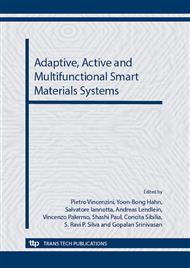[1]
R.L. Oréfice, M.M. Pereira, H.S. Mansur, Biomateriais – Fundamentos e Aplicações, first ed., Ed. Cultura Médica, Rio de Janeiro, (2006).
Google Scholar
[2]
X. Liu, P.K. Chu, C. Ding, Surface modification of titanium, titanium alloys, and related materials for biomedical applications, Mat. Science Eng. R. 47 (2004) 49-121.
DOI: 10.1016/j.mser.2004.11.001
Google Scholar
[3]
F.A. Müller, M.C. Bottino, L. Müller, V.A.R. Henriques, U. Lonhbauer, A.H.A. Bressiani, J.C. Bressiani, In vitro apatite formation on chemically treated (P/M) Ti-13Nb-13Zr, Dent. Mat. 24 (2008) 50-56.
DOI: 10.1016/j.dental.2007.02.005
Google Scholar
[4]
S. Franz, S. Rammelt, D. Scharnweber, J.C. Simon, Immune responses to implants – A review of the implications for the design of immunomodulatory, Biomat. 32 (2011) 6692-6709.
DOI: 10.1016/j.biomaterials.2011.05.078
Google Scholar
[5]
L. L. Guéhennec, A. Soueidan, P. Layrolle, Y. Amouriq, Surface treatments of titanium dental implants for rapid Osseointegration, Dent. Mat. 2 3 (2007) 844–854.
DOI: 10.1016/j.dental.2006.06.025
Google Scholar
[6]
T.S. Goia, K.B. Violin, M. Yoshimoto, J.C. Bressiani, A.H.A. Bressiani, Osseointegration of titanium alloy macroporous implants obtained by PM with addition of gelatin, Adv. Science Techn. 76 (2010) 259-263.
DOI: 10.4028/www.scientific.net/ast.76.259
Google Scholar
[7]
I.J. Goldstein, C.E. Hayes, The lectins: carbohydrate binding proteins of plants and animals, Advan. Carbo. Chem. Bioch. 35 (1978) 127-340.
DOI: 10.1016/s0065-2318(08)60220-6
Google Scholar
[8]
B. Alberts, A. Johnson, J. Lewis, M. Raff, K. Roberts, P. Walter, The Cell, four ed., Ed. Garland Science, New York, (2002).
Google Scholar
[9]
N. Sharon, H. Lis, History of lectins: from hemagglutinins to biological recognition molecules. Glycobio. 14 (2004) 53R-62R.
DOI: 10.1093/glycob/cwh122
Google Scholar
[10]
M. Ambrosi, N.R. Cameron, B.G. Davis, Lectins: tools for the molecular understanding of the glycocode, Org. Biomol. Chem. 3 (2005) 1593-1608.
DOI: 10.1039/b414350g
Google Scholar
[11]
J. Alroy, G. R. De, C.D. Warren, Application of lectin histochemistry and carbohydrate analysis to the characterization of lysosomal storage diseases, Carbohydr. Res. 213 (1991) 229-250.
DOI: 10.1016/s0008-6215(00)90611-6
Google Scholar
[12]
L.K. Mahal, Glycomics: towards bioinformatic approaches to understanding glycosylation. Anticancer Agents. Med. Chem. 8 (2008) 37-51.
DOI: 10.2174/187152008783330806
Google Scholar
[13]
A. Taraszewska, E. Matyja, Lectin binding pattern in meningiomas of various histological subtypes, Folia. Neuropathol. 45 (2007) 9-18.
Google Scholar
[14]
S. Niikawa, A. Hara, T. Ando, N. Sakai, H. Yamada, K. Shimokawa, Dolichos biflorus agglutinin binding to intracranial germ-cell tumors: detection of embryonal components in germinomas, Acta Neuropathol. 83 (1992) 347-351.
DOI: 10.1007/bf00713524
Google Scholar
[15]
S. Nakahara, A. Raz, Biological modulation by lectins and their ligands in tumor progression and metastasis. Anticancer Agents Med. Chem. 8 (2008) 22-36.
DOI: 10.2174/187152008783330833
Google Scholar
[16]
O. Suzuki, M. Abe, Cell surface N-glycosylation and sialylation regulate galectin-3-induced apoptosis in human diffuse large B cell lymphoma, Oncol. Rep. 19 (2008) 743-748.
DOI: 10.3892/or.19.3.743
Google Scholar
[17]
R. Bilyy, R. Stoika, Search for novel cell surface markers of apoptotic cells, Autoimmunity. 40 (2007) 249-253.
DOI: 10.1080/08916930701358867
Google Scholar


